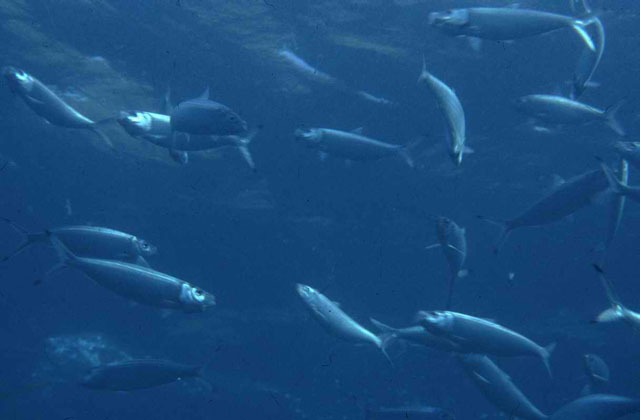| Atlantic Ocean: southern and eastern parts of Mediterranean Sea, also penetrating the Suez Canal (Ref. 188, 50345), and eastern Atlantic Ocean, from Gibraltar southward to Angola and a single recorded specimen from Walvis Bay in Namibia (Ref. 188, 5286, 81269, 81631, 86940). |
|
Dorsal spines (total): 0-0; Dorsal soft rays (total): 18-23; Anal spines: 0-0; Anal soft rays: 17-23; Vertebrae: 44-48. Diagnosis: Body elongate, but variable in depth, belly fairly sharply keeled; with 14-20 pre-pelvic and 12-15 post-pelvic scutes, total scutes 31-34; lower gillrakers 70-166, increasing with growth; upper pectoral finrays white on outer side, the membrane between black (Ref. 188, 3259, 81269, 81631). It resembles Sardinella aurita, but pelvic fin with 1 unbranched and 7 branched rays vs. 1 unbranched and 8 branched rays in S. aurita and no black spot on hind part of gill cover, but faint gold or black area just behind gill opening (Ref. 187, 188). It is distinguished from S. rouxi by having more lower gillrakers, which is only 30-40 in S. rouxi, and the caudal fin grey, its tips almost black vs. pale yellow with distal margin dusky in S. rouxi (Ref. 187, 188, 81269).
Description: Body elongate, but variable in depth, belly fairly sharply keeled (Ref. 188, 81269, 81631). Eye moderate, more than 3 times in head length; mouth terminal (Ref. 187). Gillrakers fine and numerous; lower limb of first gill arch with 70-166 gillrakers, increasing with growth (Ref. 187, 188, 3259, 81269, 81631). Dorsal fin with 3-4 unbranched and 14-19 branched rays, dorsal fin origin a little before midpoint of body; anal fin with 3 unbranched and 14-19 branched rays, anal fin origin well behind dorsal fin base; pectoral fin with 1 unbranched and 13-16 branched rays; and pelvic fins with 1 unbranched and 7 branched rays (Ref. 187, 1989, 2849, 3259, 81269, 81631, 102353). Scales cycloid; 40-50 in a longitudinal series to base of caudal fin; 11-13 in transverse series (Ref. 3259, 43853, 81269, 81631, 121227). Belly compressed, with sharp keel of scutes, becoming more rounded in adults; 14-20 pre-pelvic scutes and 12-15 post-pelvic mid-ventral scutes (Ref. 2849, 3259, 81269, 81631). Vertebrae 44-48 (Ref. 815, 1989, 121227).
Colouration: Alcohol-preserved specimens are silvery (Ref. 81269, 81631). Upper pectoral-fin rays externally white, while fin membranes are black; caudal fin greyish with black tipped lobes; no postopercular spot, but a golden or sometimes blackish area just behind gill opening (Ref. 188, 2849, 81269, 81631). Dorsal fin yellow with dusky margin and a black spot at base of anterior finrays (Ref. 2945). |
| A coastal, pelagic species, but tolerant of low salinities (Ref. 188, 5286, 27000, 86940); sometimes in estuaries and lagoons (Ref. 188, 2683). It forms schools, preferring waters of 24°C, at surface or at bottom down to 50m, strongly migratory (Ref. 188, 5286). It feeds on a variety of small planktonic invertebrates, also fish larvae and phytoplankton (Ref. 188, 27165). It breeds only once in the year, during the warm season between July and September, in coastal waters; juveniles and adults show clear north-south migrations in the Gabon-Congo-Angola sector and the Sierra Leone-Mauritania sector of the Atlantic Ocean, each area having nurseries; these movements are correlated with the seasonal upwelling (Ref. 188). It is of considerable importance off West African coasts, but combined with Sardinella aurita in most statistics, partly because both species are often caught together (Ref. 188). |

